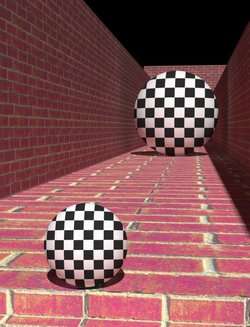There's more than meets the eye in judging the size of an object

You can't always trust your eyes. Neuroscientists from the University of Washington and the University of Minnesota have found that the first area in the cortex of the human brain that receives information from the eyes processes the perceived size, rather than the actual size, of an object.
"Our eyes only tell us part of what we need to be able to see. The other part is done by the brain, taking the input from the eyes and making guesses or inferences about what's out there in the environment. Usually these inferences are very accurate, but sometimes they lead us astray in the form of visual illusions," said Scott Murray, a UW assistant psychology professor and lead author of a study published in the current issue of Nature Neuroscience.
Murray and his Minnesota colleagues, Huseyin Boyaci and Daniel Kersten, used functional magnetic resonance imaging (fMRI) to see how the brain processes the size of objects when faced with an illusion such as the long-known moon illusion. For centuries it has been known that the moon, while rising, looks huge when it is near the horizon and smaller when high in the sky. It is in reality always the same size.
The researchers used a similar illusion, one that looked at the perceived difference in the size of an object at different distances. For their experiment they placed two identical spheres decorated with a checkerboard pattern in the front and rear of a receding brick hallway. In this kind of illusion, the more distant object appears to occupy a larger portion of the visual field.
Using fMRI, the researchers examined how the brains of five people with normal vision registered this difference in perceived size. They found that the brain region known as the primary visual cortex, which is the first area in the cortex to receive input from the retina, showed a difference. Even though both spheres occupied exactly the same size on the retina, the rear sphere activated an approximately 20 percent larger area in the primary visual cortex than the front sphere. This difference closely matched a perceptual difference in size made by the subjects. Asked about the size of the two spheres, the people estimated the back sphere to be about 20 percent larger than the front one.
Murray said the simplicity of the results can belie its importance to anyone not involved in vision research.
"It almost seems like a first grader could have predicted the result. But virtually no vision or neuroscientist would have. The very dominant view is that the image of an object in the primary visual cortex is just a precise reflection of the image on the retina. I'm sure if one were to poll scientists, 99 percent of them would say the 'large' moon and the 'small' moon occupy the same amount of space in the primary visual cortex , assuming they haven't read our paper!"
Murray said such illusions are more than simple curiosities because they can help identify how the visual system works.
"Our finding is important because it demonstrates that the process of making inferences about visual properties in our environment is occurring in the earliest stages of the visual system," he said. "Researchers have long believed that the visual system is organized hierarchically, with early visual areas such as the primary visual cortex simply registering the physical input from the eyes and 'higher' visual areas attempting to put all the information together. This work challenges these theories of the organization of the visual system."
Source: University of Washington





















